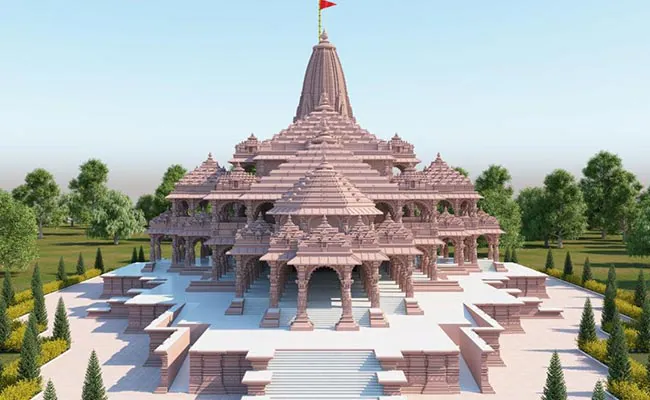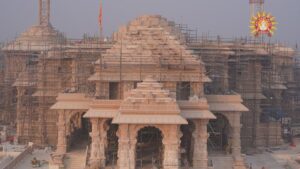History of Ram Mandir

Introduction
This article provides an overview of the history of Ram Mandir. also known as Ram Janmabhoomi, which holds significance in Hinduism as the alleged birthplace of Lord Rama. an incarnation of Vishnu. In the 16th century, during temple raids in northern India. Babur destroyed temples, leading to the construction of the Babri Masjid on the disputed site. Religious violence was first recorded in 1853 and in 1858 the British government banned worship at the disputed sites.
Devotees went to Ayodhya during the Rath Yatra in 1990, resulting in partial damage to the mosque. Then the state government led by Mulayam Singh Yadav announced a bandh to maintain order. The historical events surrounding Ram janmabhoomi reflect the complex religious and political dynamics in India.

Babri Masjid image 1992
History of Ram Mandir Ayodhya
About Ram Mandir
Rama, an incarnation of Lord Vishnu, is a revered Hindu deity, born in Ayodhya, Ramayana.The Mughals constructed the Babri Mosque in the 16th century, considering it the birthplace of Rama.There was a violent conflict in the 1850s. In the 1980s, the Vishwa Hindu Patriarchate (VHP) established a temple for the infant Rama and asserted Hindu rights.
In 1989, the VHP laid the foundation of a temple near the controversial mosque. A 1992 rally by the VHP and the Bharatiya Janata Party led to the demolition of mosques, months of riots, 2,000 deaths. and attacks on Hindu temples in Pakistan and Bangladesh. There were 2005 terrorist attacks and legal disputes. The Supreme Court order in 2019 eased the construction of the Ram temple.
The Main Temple
The Ram Temple complex in Ayodhya, India encompasses a sacred site of historical and religious significance. Considered to be the birthplace of Lord Rama, an avatar of Vishnu, the place has witnessed a turbulent history. It was earlier the site of the Babri Masjid, which was built during Mughal rule after the destruction of the existing temples. The mosque faced controversy, leading to communal tension. In 1992, the mosque was demolished, and efforts to build a Ram temple gained momentum.
The area has since undergone extensive redevelopment, and the construction of the magnificent Ram Temple is a symbolic representation of the Hindu cultural revival. Pilgrims and visitors now flock to Ayodhya to experience the spiritual and architectural splendor of this revered place.

Total area: 2.7 hectares
built area: 57,400 square meters.
length Area of the temple: 360 feet
width Area of the temple: 235 feet
The height Area of the temple is 161 feet
Number of floors: 3
Height of each floor: 20 feet
Number of columns in the field
Ram Mandir Case
Ancient References and Significance
The belief that Ayodhya is the birthplace of Lord Rama is rooted in Hindu tradition and religious texts like the Ramayana and Ramcharitmanas. According to these texts, Ayodhya was the capital of the Kosala kingdom, and King Dasharatha, Rama’s father, ruled from there. The area has been considered sacred for centuries, with records of Hindu worship at the site dating back to ancient times.
Medieval Period and the Babri Masjid (1528-1853)
- In 1528, during the rule of the Mughal emperor Babur, the Babri Masjid was constructed. According to Hindu accounts, this was done after demolishing a pre-existing Hindu temple.
- The existence of a temple before the mosque is a subject of historical and archaeological debate. However, Hindu religious traditions continued in the area despite the construction of the mosque.
- By the 18th century, Hindu ascetics like the Naga Sadhus were known to have reclaimed parts of the site for worship.
Colonial Era and British Rule (1853-1947)
- The first recorded conflict over the site occurred in 1853, when religious riots broke out between Hindus and Muslims.
- In 1858, following the Revolt of 1857, the British colonial administration imposed restrictions on worship at the site to maintain order.
- In 1885, a Hindu priest, Raghubar Das, filed a petition in a Faizabad court, seeking permission to build a temple on the premises, but the court denied the request.
- The British government, in 1886, noted that while Hindus believed the site to be the birthplace of Rama, there was no substantial proof of the claim.
Post-Independence Disputes (1949-1984)
- In 1949, an idol of Rama Lalla (infant Rama) was mysteriously placed inside the Babri Masjid. This led to communal tensions, and the government locked the site, prohibiting public access.
- In 1950, multiple court cases were filed by Hindu groups demanding the right to worship at the site.
- In 1984, the Vishva Hindu Parishad (VHP) launched a campaign to reclaim the site and build a Ram temple. The movement gained momentum in the coming years, backed by the Bharatiya Janata Party (BJP).
Ram Janmabhoomi Movement and Babri Masjid Demolition (1986-1992)
- In 1986, a court ruling allowed Hindu worshippers to access the site, leading to increased communal tensions.
- In 1990, BJP leader L.K. Advani led the Rath Yatra, a nationwide rally advocating for the construction of the temple. The rally led to violent clashes and was stopped by the then Uttar Pradesh government.
- On December 6, 1992, a large crowd gathered at Ayodhya for a rally organized by Hindu nationalist groups. The mob demolished the Babri Masjid, leading to widespread riots across India, Pakistan, and Bangladesh.
- The Liberhan Commission was set up to investigate the events, and its report (released in 2009) held several political and religious leaders responsible for the demolition.
Legal and Political Developments (1993-2019)
- In 1993, the Acquisition of Certain Area at Ayodhya Act was passed, allowing the central government to acquire 67 acres of land around the disputed site.
- In 2002, the Godhra train burning incident, where Hindu pilgrims returning from Ayodhya were killed, led to communal riots in Gujarat.
- The Archaeological Survey of India (ASI) conducted excavations at the site in 2003, and its report suggested evidence of a temple-like structure beneath the mosque.
- The Allahabad High Court, in 2010, ruled that the land should be divided among Hindus, Muslims, and the Nirmohi Akhara.
Supreme Court Verdict and Construction of Ram Mandir (2019-Present)
- On November 9, 2019, the Supreme Court of India delivered a unanimous verdict:
- The disputed land was given to the Ram Janmabhoomi Trust for the construction of a temple.
- A 5-acre alternative plot was allotted to the Sunni Waqf Board to build a mosque elsewhere.
- On August 5, 2020, Prime Minister Narendra Modi performed the Bhoomi Pujan (foundation-laying ceremony) for the temple.
- The Ram Temple is being constructed in a grand style, following traditional Hindu architecture. It is set to become one of the most important religi.
Conclusion
The history of Ram Mandir reflects centuries of religious, political, and legal conflicts. The site has been a symbol of Hindu faith for millennia, but its history has been marked by disputes, violence, and legal battles. With the Supreme Court’s verdict and the construction of the temple, Ayodhya is now set to emerge as a major pilgrimage and cultural center.









Recent Comments